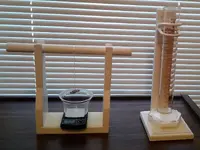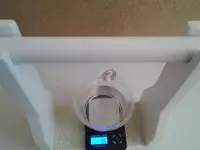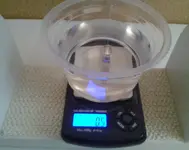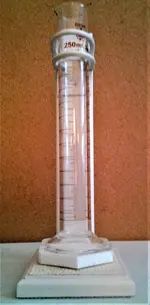ToddB64
Sr. Member
- Joined
- Jan 7, 2007
- Messages
- 418
- Reaction score
- 73
- Golden Thread
- 0
- Location
- Georgetown, Ohio, USA
- Detector(s) used
- Teknetics Gamma 6000,
Tesoro Bandido II µMax and
Compadre, White's Classic II,
Garrett Ace 250
- Primary Interest:
- Metal Detecting
- #1
Thread Owner
Hi ! 
If interested in testing the density of your jewelry to determine it's value, read on.....
The (4) pictures attached show my handmade test stands made of wood and painted white.
In this instance we are only concerned with the water bowl/digital scale test method based on the Archimedes principle. (The Graduated cylinder is another method of determining density, but not addressed in this post.)
#1 First, the digital scale is turned ON and the item is weighed dry and the weight recorded.
#2 Then a clear-plastic bowl of distilled water is set on the scale and the Tare button pressed to subtract both the weight of the bowl plus the water .... the scale then reads 0.00. The item in this instance, a 92.5 % Sterling Silver ladies' ring (found metal detecting a soccer field), is hanging by a length of 4 lb. monofilament fishing line, with the upper end wound around a 1" dia. hardwood dowel resting on supports.
#3 The dowel is rotated to lower the ring into the bowl of water until fully submerged, but the ring cannot be touching the sides or bottom of the bowl.
#4 Wait for the ring to settle and stop moving in the water.
#5 The digital scale is weighing just the amount of water displaced by the ring. Record the weight of the displaced water.
#6 Divide the dry weight of the ring (larger number) by the weight of the displaced water (smaller number) and the quotient is the density of the ring. Eureka !
#7 Compare the quotient to the Density column in a Periodic Table to find out what metal the ring is made of, allowing for the fact that density tables are based on pure elements, be they solids, liquids or gases, and the metal of the ring is not pure, so some interpolation of the density number chosen from the table will be neccessary when making a final decision of the metal.
Hope this helps someone !
Toddb64

If interested in testing the density of your jewelry to determine it's value, read on.....
The (4) pictures attached show my handmade test stands made of wood and painted white.
In this instance we are only concerned with the water bowl/digital scale test method based on the Archimedes principle. (The Graduated cylinder is another method of determining density, but not addressed in this post.)
#1 First, the digital scale is turned ON and the item is weighed dry and the weight recorded.
#2 Then a clear-plastic bowl of distilled water is set on the scale and the Tare button pressed to subtract both the weight of the bowl plus the water .... the scale then reads 0.00. The item in this instance, a 92.5 % Sterling Silver ladies' ring (found metal detecting a soccer field), is hanging by a length of 4 lb. monofilament fishing line, with the upper end wound around a 1" dia. hardwood dowel resting on supports.
#3 The dowel is rotated to lower the ring into the bowl of water until fully submerged, but the ring cannot be touching the sides or bottom of the bowl.
#4 Wait for the ring to settle and stop moving in the water.
#5 The digital scale is weighing just the amount of water displaced by the ring. Record the weight of the displaced water.
#6 Divide the dry weight of the ring (larger number) by the weight of the displaced water (smaller number) and the quotient is the density of the ring. Eureka !
#7 Compare the quotient to the Density column in a Periodic Table to find out what metal the ring is made of, allowing for the fact that density tables are based on pure elements, be they solids, liquids or gases, and the metal of the ring is not pure, so some interpolation of the density number chosen from the table will be neccessary when making a final decision of the metal.
Hope this helps someone !
Toddb64

Attachments
Last edited:







 However, she did pretty good with that for much longer than I thought she would. Then I began to notice some reluctance earlier this year. She's never been interested in metal detecting and it's probably boring for her after taking the pooch for a walk around the park and then having to wait for me to wear out, so I'm sure this routine is getting old.
However, she did pretty good with that for much longer than I thought she would. Then I began to notice some reluctance earlier this year. She's never been interested in metal detecting and it's probably boring for her after taking the pooch for a walk around the park and then having to wait for me to wear out, so I'm sure this routine is getting old.
